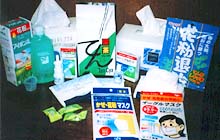 |
 |
 |
 |
 |
 |
|||||
 |
 |
 |
 |
| ALLERGY SEASON ARRIVES: This Year Threatens to Be the Worst Yet March 17, 2000  Products to combat hay fever are selling well. When spring arrives, so do the runny noses, itchy eyes, and other discomforts associated with hay fever. Allergies are a common ailment in Japan, afflicting one in 10 people. The culprits of hay fever include pollen from the Japanese cypress and white birch trees, but the worst offender by far is cedar pollen. Because of last year's exceptionally hot summer, the cedar pollen count in many parts of Japan is expected to be much higher this spring than usual. In the most severely afflicted parts of the Kanto area (the region where Tokyo is located), forecasters are predicting up to 10 times the amounts measured last year; this is likely to cause many new cases of hay fever. A slew of anti-allergy products have come on the market--not only allergy medicines, but also protective devices such as masks, goggles, and even pollen-repellent coats. But once a person gets hay fever for the first time, it is hard to cure. The only thing one can do is prepare for a long battle, and take defensive measures early. Up to 10 Times More Pollen than 1999 The large numbers of cedar trees growing throughout Japan are the legacy of postwar afforestation projects. There is therefore an especially high volume of pollen in Japan, and according to estimates, half of the Japanese population has antibodies to cedar pollen. Just having antibodies for a given substance does not guarantee that a person's immune system will overreact and cause the person to become allergic to that substance. Still, people have been known to develop allergies overnight. Besides the 10% of the Japanese population that already suffers from hay fever, an estimated additional 40% could develop it at any time. According to the Japan Weather Association's forecasts, the levels of pollen in the air this year will be high in the east and low in the west. A hot summer favors growth of male cedar flowers, the ones that produce the pollen. Eastern Japan, where temperatures last July and August were higher than average, will have a higher pollen count than usual, while western Japan, which had lower-than-average summer temperatures, will have less pollen in the air than usual. Furthermore, because winter 1999-2000 was warm, with temperatures 3 to 4 degrees above average, the cedar trees are flowering and scattering their pollen about a week earlier than usual. The Tokyo metropolitan government has measured pollen counts of 3 times the average, and the trees in the capital region scattered their pollen in early February, about 10 days earlier than usual. Meanwhile, in Chiba Prefecture, east of Tokyo, pollen counts are about 10 times the low levels observed last year. The volume of cypress pollen--which, like cedar pollen, causes allergies--is also expected to be high in eastern Japan. Cypress trees scatter their pollen about a month after the cedar trees do. So in the Kanto and Tokai regions, where there are a lot of cypress trees, the pollen blizzard that started in early February is not likely to let up until early May. Planting Low-Pollen Cedar Trees But no matter how careful allergy sufferers are, they will inevitably come into contact with some pollen. Mild symptoms can be treated with over-the-counter allergy medicines, which many people take. Allergists point out that these medicines are most effective when people begin taking them two weeks before pollen starts to scatter, so it is best to start taking them early. When hay fever symptoms are beyond the powers of over-the-counter remedies, allergists boost their patients' immunity by injecting them with extracts of cedar pollen or other pollen. However, the effects of shots taken this year will not show up until next year or later, so injections are not effective against sudden allergy attacks. A more recently devised approach to combating hay fever is to reduce the actual volume of pollen in the air. In 1998, a forestry research institute in Chiba Prefecture started planting a superior variety of cedar tree that produces little pollen, and it plans to plant more of these trees. The Tokyo Metropolitan Government has begun providing pollen-related information over the phone and on its web site. Since about February TV and newspaper weather reports have also begun to include daily pollen forecast.  Edited by Japan Echo Inc. based on domestic Japanese news sources. Articles presented here are offered for reference purposes and do not necessarily represent the policy or views of the Japanese Government. Edited by Japan Echo Inc. based on domestic Japanese news sources. Articles presented here are offered for reference purposes and do not necessarily represent the policy or views of the Japanese Government.
|

